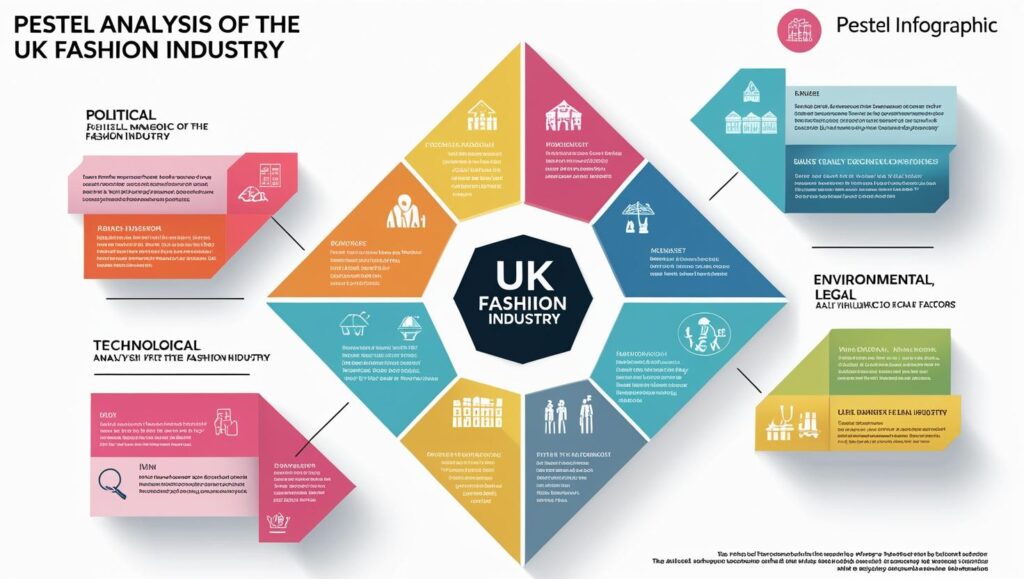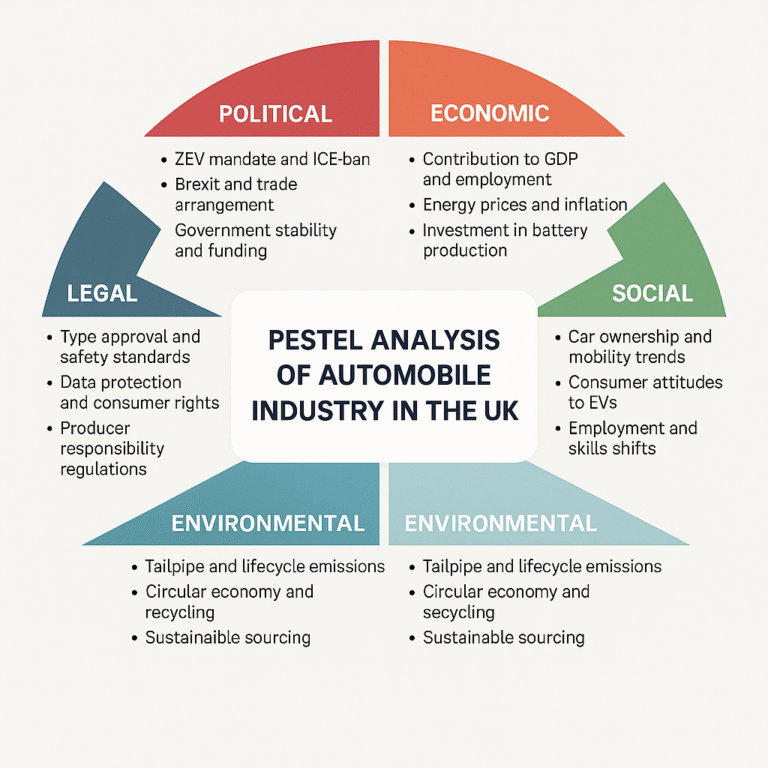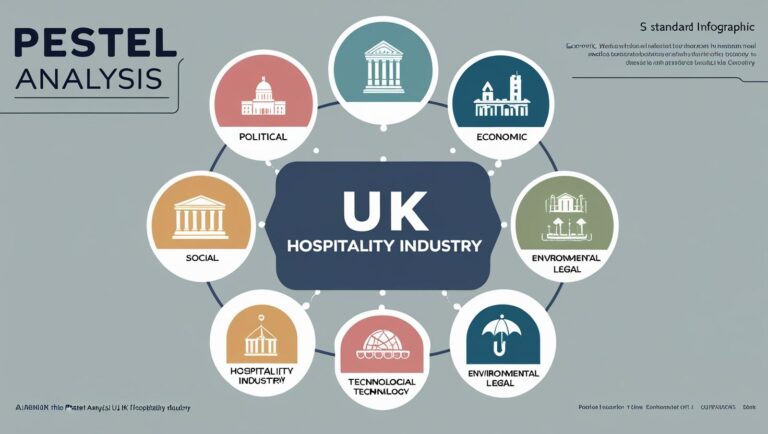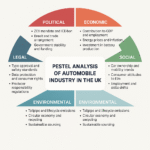Summary of Pestel Analysis of Fashion Industry in UK
The UK fashion industry significantly contributes to environmental challenges through high textile waste, carbon emissions, excessive water use, and the widespread use of synthetic fibres that release microplastics. Driven by fast fashion, overproduction and short garment lifecycles exacerbate landfill pressure and pollution. However, rising consumer awareness, advancements in sustainable materials, and the growth of circular fashion models like resale and rental are pushing the industry toward greener practices. Governmental pressure and cultural shifts are also prompting brands to improve transparency and environmental accountability.
Political Analysis of the Fashion Industry in the UK
The fashion industry in the United Kingdom operates within a complex political landscape that significantly influences its stability, regulation, and international competitiveness. Several key political factors impact the sector:
1. Government Regulations and Policy Framework
The UK government enforces a range of regulations affecting the fashion industry, including labor laws, consumer protection standards, and environmental regulations. For example:
- Modern Slavery Act 2015: This legislation requires fashion companies to disclose efforts to prevent slavery and human trafficking in their supply chains.
- Minimum wage and employment laws: These ensure fair labor practices, affecting operational costs for fashion retailers and manufacturers.
Compliance with these laws affects both reputation and cost structures, especially for large fashion brands with global supply chains.
2. Brexit and Trade Policies
The UK’s departure from the EU has had profound effects on the fashion industry:
- Tariffs and customs delays: Importing textiles and exporting finished goods to the EU now involves greater friction and cost.
- Visa and labor restrictions: Reduced access to European labor has contributed to staffing challenges in manufacturing and retail.
- Rules of origin requirements: Products must meet specific criteria to qualify for tariff-free trade, complicating supply chain logistics.
While some companies have localized operations to adapt, smaller brands have faced disproportionate burdens.
3. Sustainability and Environmental Legislation
As political pressure mounts around climate change, the UK government is increasing regulatory focus on environmental impact:
- Extended Producer Responsibility (EPR): Proposed schemes could make brands responsible for the lifecycle of garments, increasing costs for fast fashion.
- Waste and recycling targets: The fashion industry is being scrutinized for its role in textile waste and overproduction.
These political moves are encouraging a shift toward sustainable and circular fashion, but not all companies are equipped to pivot quickly.
4. Trade Agreements and International Relations
Post-Brexit, the UK is pursuing independent trade agreements with countries like Australia, India, and members of the CPTPP:
- These agreements can open new markets for British designers and manufacturers but also increase competition from lower-cost imports.
- Trade friction with the EU remains a concern, especially for luxury brands and heritage textile producers reliant on European suppliers.
5. Political Support and Funding for Creative Industries
The UK government has acknowledged fashion as a key contributor to the creative economy:
- British Fashion Council (BFC) receives funding and policy support to promote UK fashion globally.
- Creative sector tax reliefs and grants are available, especially for small and medium enterprises.
However, inconsistent funding and shifting priorities (e.g., due to budget constraints or political changes) pose risks to long-term growth.
6. Geopolitical Instability and Global Supply Chains
The UK fashion industry is affected by international political developments:
- Tensions in Asia (e.g., China) can disrupt textile imports and affect pricing.
- Conflicts and sanctions (e.g., Russia-Ukraine) influence consumer sentiment, raw material availability, and global retail operations.
As supply chains become more fragile, UK fashion businesses are reassessing dependencies and exploring near-shoring options.
Economic Analysis of the Fashion Industry in the UK
The fashion industry plays a crucial role in the UK economy, contributing significantly to employment, exports, and consumer spending. However, like many sectors, it faces evolving economic pressures and opportunities shaped by global and domestic trends.
1. Contribution to the UK Economy
The UK fashion industry is a substantial economic contributor:
- Valuation: Estimated to be worth over £26 billion to the UK GDP (as of recent industry reports).
- Employment: Supports around 800,000 jobs, spanning retail, design, manufacturing, marketing, and logistics.
- Exports: British fashion is globally recognized, with exports of textiles and apparel reaching over £9 billion annually.
Luxury fashion and heritage brands are especially important in the global positioning of UK fashion.
2. Consumer Spending and Inflation
Fashion is a discretionary spending category and closely tied to consumer confidence:
- Inflation impact: Recent inflationary pressures have reduced disposable income, shifting demand toward affordable fashion or second-hand markets.
- Value vs. luxury: While fast fashion brands like Primark continue to perform well, premium and luxury segments have been more resilient due to higher-income consumers being less sensitive to inflation.
- Cost of living crisis: The broader economic downturn has changed purchasing behavior, with more emphasis on value, durability, and ethical sourcing.
3. Post-Brexit Economic Adjustment
Brexit continues to influence the economic structure of the industry:
- Increased costs: Customs duties, shipping delays, and compliance with rules of origin have increased operational expenses, especially for SMEs.
- Labor shortages: EU workforce loss has affected warehouse staffing, tailoring, and logistics, leading to higher wages and reduced flexibility.
- Currency fluctuations: The depreciation of the pound has made imports more expensive but helped boost the competitiveness of UK-made products abroad.
4. Supply Chain and Production Economics
The global nature of the fashion supply chain has exposed the UK industry to economic vulnerabilities:
- Rising raw material costs (cotton, dyes, synthetic fibers) driven by global demand and geopolitical tensions have squeezed margins.
- Logistics and shipping costs surged during and after COVID-19 and remain volatile due to energy prices and international disruption (e.g., Red Sea conflict).
- Shift to nearshoring: Brands are reassessing production strategies to reduce dependence on Asia, supporting growth in UK-based and Eastern European manufacturers.
5. E-commerce and Digital Economy
The growth of e-commerce has reshaped the fashion retail landscape:
- Online retail now accounts for over 30% of clothing sales in the UK.
- Digital platforms enable global reach but increase competition and price sensitivity.
- Fashion tech, AI-driven trend forecasting, and digital fitting tools are becoming economically essential for efficiency and customer engagement.
E-commerce growth has also increased the burden of returns processing, which carries high logistical and environmental costs.
6. Investment and Innovation
Despite economic headwinds, investment continues in key areas:
- Sustainability innovation: Circular fashion, biodegradable materials, and rental platforms are attracting venture capital and policy support.
- Tech adoption: AI, AR, blockchain, and automation are driving new efficiencies and reshaping fashion business models.
- SME challenges: Smaller brands often lack access to capital and struggle with scaling in a high-cost, low-margin environment.
Government and private-sector support remain critical for fostering innovation in the UK’s competitive fashion scene.
7. Regional Economic Impact
Fashion’s economic contribution varies across UK regions:
- London remains the epicenter for high fashion, creative talent, and global exposure.
- Manchester, Leeds, and Leicester are key hubs for textile production and fast fashion logistics.
- Regional disparity in economic support and infrastructure has implications for employment and local economies dependent on fashion manufacturing.
Social Analysis of the Fashion Industry in the UK
The UK fashion industry is deeply influenced by shifting social dynamics, including changing demographics, evolving consumer values, and cultural movements. Understanding these social factors is essential for brands aiming to remain relevant and responsive to public expectations.
1. Changing Consumer Values and Conscious Consumption
UK consumers are becoming more ethically and environmentally conscious:
- Sustainability and ethical labor practices are now significant purchasing considerations, especially among Millennials and Gen Z.
- The rise of slow fashion and second-hand shopping reflects growing disapproval of fast fashion’s environmental and social impact.
- Consumers are increasingly demanding transparency in supply chains, pushing brands to disclose sourcing and manufacturing practices.
This shift is forcing traditional retailers to rebrand or reform their operations to align with socially responsible values.
2. Cultural Diversity and Inclusion
The UK is a multicultural society, and its fashion industry reflects this:
- There is a growing demand for inclusive representation in campaigns, including different races, body types, ages, genders, and abilities.
- Fashion brands are being held accountable for cultural appropriation and are expected to show genuine respect for diversity and heritage.
- Modest fashion and ethnically inspired designs have become more mainstream, influenced by Britain’s ethnically diverse population.
Consumers now expect brands to not only reflect but also actively support diversity and inclusion in both their messaging and internal practices.
3. The Role of Social Media and Influencer Culture
Social media platforms such as Instagram, TikTok, and YouTube have radically transformed fashion trends and marketing:
- Influencers and content creators shape buying habits and style trends, often more effectively than traditional advertising.
- Fast-moving micro-trends (like TikTok “cores”) have shortened the fashion cycle and increased pressure on brands to constantly release new styles.
- User-generated content and viral challenges have democratized fashion, giving more voice to everyday consumers and niche creators.
This trend empowers consumers but also contributes to overconsumption and fast fashion culture.
4. Youth Culture and Identity Expression
Fashion remains a key vehicle for self-expression, especially among young people:
- Young consumers use clothing to express identity, political beliefs, sexuality, and individuality.
- There is rising popularity of gender-neutral or non-binary fashion, reflecting broader societal shifts around gender and identity.
- Fashion is closely linked to social justice movements, with brands expected to take stances on issues like racism, climate change, and LGBTQ+ rights.
Brands that stay silent on social issues risk being perceived as out of touch or performative.
5. Health, Wellness, and Body Image Awareness
Social concerns around mental health and body image are reshaping the industry:
- There is increased advocacy for body positivity and mental health support, leading to broader representation in modeling and advertising.
- Fashion brands are being scrutinized for promoting unhealthy standards, with calls for realistic portrayals of beauty and size inclusivity.
- Wellness and comfort are also influencing design trends, with growing interest in athleisure, loungewear, and functional fashion.
The pandemic accelerated these trends, making comfort and emotional well-being more central to fashion choices.
6. Demographic Shifts and Aging Population
While youth trends dominate fast fashion, the UK also has an aging population:
- Older consumers are increasingly fashion-conscious, with growing demand for age-inclusive styles that combine comfort, functionality, and style.
- Brands that overlook this demographic risk missing out on a segment with strong purchasing power and brand loyalty.
- Multi-generational marketing and adaptive fashion (for people with disabilities or mobility issues) are gaining traction.
Catering to all life stages is becoming a social imperative for long-term brand relevance.
7. Social Mobility and Class Identity
Fashion in the UK is also linked to social class and status:
- Streetwear and high fashion often borrow from working-class aesthetics, creating a tension between authenticity and commodification.
- The rise of rental fashion and subscription services reflects changing attitudes toward ownership and accessibility in an unequal economy.
- Consumer choice is increasingly shaped by awareness of the social and ethical consequences of consumption, not just aesthetics or affordability.
This dynamic influences how fashion brands position themselves in a class-conscious society.
Technological Analysis of the Fashion Industry in the UK
Technology is transforming every aspect of the UK fashion industry—from design and production to retail and customer experience. Innovation is not only a competitive advantage but also a necessity in an increasingly digital, fast-paced, and sustainability-conscious market.
1. E-commerce and Digital Transformation
The UK fashion sector has seen a major digital shift:
- Online sales account for over 30% of total fashion retail in the UK.
- Digital storefronts have become the primary channel for many brands, reducing dependency on physical stores.
- Fashion retailers use AI and data analytics to personalize shopping experiences, improve recommendations, and reduce cart abandonment.
Major players like ASOS and Boohoo have built entire business models around agile e-commerce infrastructure, but smaller brands are also investing heavily in digital capabilities.
2. Artificial Intelligence and Machine Learning
AI is reshaping fashion in several key areas:
- Trend forecasting: Machine learning models analyze social media, search data, and past trends to predict demand.
- Inventory optimization: AI helps prevent overproduction and stockouts by forecasting demand more accurately.
- Virtual stylists and chatbots: These enhance customer support and drive sales through personalized interaction.
AI adoption also supports sustainable practices by reducing waste and improving production efficiency.
3. Virtual and Augmented Reality (VR/AR)
Immersive technologies are being used to enrich the shopping experience:
- Virtual fitting rooms allow customers to try on clothes digitally, improving confidence in purchases and reducing returns.
- AR filters on mobile apps enable users to preview items in real-time using their phone camera.
- Virtual fashion shows and 3D lookbooks have gained traction, especially during and after the pandemic.
These technologies bridge the gap between digital convenience and tactile, in-store experiences.
4. 3D Design and Digital Prototyping
Fashion design is moving into the digital realm:
- 3D modeling software like CLO and Browzwear enables designers to create and test garments virtually.
- Digital sampling reduces the need for physical prototypes, speeding up product development and minimizing waste.
- Digital twins and CAD tools support customization, precision, and faster time-to-market.
This shift is particularly valuable for small and independent designers who need cost-effective innovation.
5. Smart Textiles and Wearable Tech
Though still emerging, smart textiles are gaining interest:
- Wearable technology (e.g., fitness clothing, heated jackets, posture correction garments) is a growing niche.
- Innovations in responsive fabrics, UV-detecting textiles, and self-cleaning materials are being explored by UK startups and research institutions.
- Collaborations between tech companies and fashion brands are producing hybrid products that combine function and style.
The UK’s research ecosystem—including institutions like Central Saint Martins—is at the forefront of textile innovation.
6. Blockchain and Supply Chain Transparency
Blockchain is being used to ensure traceability and transparency:
- It enables brands to track materials from source to sale, helping validate sustainability claims.
- Consumers can scan QR codes or NFC tags to see the journey of a product, increasing trust.
- Blockchain also supports anti-counterfeiting efforts in luxury fashion.
This technology is aligned with consumer demand for ethical and transparent fashion.
7. Automation and Robotics in Manufacturing
Automation is revolutionizing garment production:
- Sewbots and automated cutting systems increase productivity and reduce human error.
- UK-based manufacturers are investing in on-demand production systems to respond to fast-changing trends.
- Although automation may reduce certain jobs, it could revive domestic manufacturing by lowering costs and reducing reliance on overseas factories.
However, implementation costs remain a barrier for many SMEs.
8. Data Analytics and Consumer Insights
Data is central to the digital fashion economy:
- Fashion brands are using real-time consumer data to drive product development, pricing strategies, and marketing.
- Analytics platforms segment audiences, monitor campaign effectiveness, and optimize digital experiences.
- Insights from social media listening and search trend analysis help identify emerging styles early.
Data-driven decisions increase agility and responsiveness in a trend-sensitive market.
Environmental Analysis of the Fashion Industry in the UK
The UK fashion industry is under increasing environmental scrutiny due to its significant ecological footprint. With growing awareness of climate change, waste, and resource depletion, both government and consumers are demanding more sustainable practices. This analysis explores the key environmental issues, risks, and responses shaping the future of UK fashion.
1. Textile Waste and Overconsumption
One of the most pressing environmental issues in UK fashion is waste generation:
- The UK is one of the largest consumers of clothing in Europe, with an estimated 300,000 tonnes of clothing ending up in landfill or incinerated annually.
- The rise of fast fashion has accelerated overproduction and short product lifecycles, encouraging a “wear once” culture.
- Despite the growth in charity shops and recycling initiatives, a large proportion of used clothing is still discarded improperly.
Pressure is mounting on brands to reduce volumes, encourage repair and resale, and adopt circular economy models.
2. Carbon Emissions and Climate Impact
Fashion has a sizable carbon footprint:
- The industry contributes around 4–10% of global carbon emissions, with much of it tied to production and transportation.
- Imported garments from Asia and other distant suppliers increase the environmental cost of logistics.
- Fast fashion brands often rely on energy-intensive manufacturing and non-renewable materials, such as polyester, further compounding the issue.
UK-based brands are increasingly being urged to decarbonize their supply chains and transition to low-impact production methods.
3. Water Use and Pollution
Fashion is a major consumer and polluter of water:
- Producing a single cotton shirt can require 2,700 liters of water—more than what one person drinks in 2.5 years.
- Dyeing and finishing processes often release toxic chemicals into water systems, especially in countries with weak environmental enforcement.
- The UK’s import-heavy fashion economy is indirectly linked to these water impacts abroad, raising concerns about outsourced pollution.
Sustainable material sourcing and closed-loop water systems are becoming key areas of innovation.
4. Microplastics and Synthetic Fibers
Synthetic fabrics like polyester, nylon, and acrylic dominate fast fashion:
- These materials shed microplastics during washing, which end up in rivers, oceans, and even the food chain.
- The UK has begun to study and address this issue, with growing advocacy for filter technology and biodegradable alternatives.
Brands are being encouraged to move away from fossil-fuel-based textiles and invest in eco-friendly fabrics.
5. Circular Fashion and Recycling Efforts
Circular economy models are gaining traction in the UK:
- Brands like Stella McCartney, Boden, and Bam Clothing are pioneering circular practices, including repair, resale, and rental services.
- Clothing rental platforms and second-hand marketplaces (e.g., Depop, Vinted) are growing rapidly, especially among Gen Z.
- However, textile recycling infrastructure in the UK is still underdeveloped, and much of the collected clothing is exported for resale or downcycling.
Policy support and investment in domestic recycling technologies are needed to scale circular solutions.
6. Sustainable Materials and Innovation
There’s increasing interest in environmentally friendly materials:
- Organic cotton, hemp, bamboo, and recycled polyester are being adopted as lower-impact alternatives.
- UK-based research institutions are exploring lab-grown leather, plant-based dyes, and bio-textiles.
- Some high-street retailers are introducing eco-conscious lines, but critics argue many are still engaged in greenwashing without meaningful change.
Transparency and certification (e.g., GOTS, OEKO-TEX) are key to consumer trust.
7. Regulatory Pressure and Policy Development
The UK government is beginning to act on environmental concerns in fashion:
- In 2019, the Environmental Audit Committee (EAC) released a critical report on fast fashion, recommending reforms that included Extended Producer Responsibility (EPR) and tax incentives for sustainable practices.
- Although many recommendations were not initially adopted, public pressure has led to growing momentum behind mandatory sustainability disclosures and regulation of textile waste.
- The Green Claims Code now regulates how brands communicate their environmental impact, aiming to curb greenwashing.
More robust regulation could significantly reshape how fashion companies operate in the UK.
8. Consumer Awareness and Activism
Environmental concerns are increasingly influencing UK consumer behavior:
- Gen Z and Millennial shoppers prioritize sustainability, transparency, and ethics, even over price in many cases.
- Campaigns such as #WhoMadeMyClothes (Fashion Revolution) and Fixing Fashion have driven awareness about the environmental cost of fast fashion.
- Consumers are demanding accountability and change, prompting brands to rethink their sourcing, packaging, and production.
Public sentiment is playing a powerful role in reshaping the environmental expectations for the industry.
Environmental Analysis of the Fashion Industry in the UK
The fashion industry in the UK faces significant environmental challenges due to its heavy resource use, high waste levels, and global supply chain impacts. With growing awareness of sustainability, the industry is under pressure from consumers, regulators, and environmental groups to reduce its ecological footprint and transition toward more responsible practices.
1. Textile Waste and Overproduction
- The UK throws away over 300,000 tonnes of clothing each year, much of which ends up in landfills or is incinerated.
- Fast fashion contributes heavily to overproduction, encouraging short-term usage and disposal.
- Despite efforts by charities and recycling programs, only a small portion of clothing is truly recycled or reused.
Impact: Increased pollution and land use; pressure on landfill capacity; higher carbon emissions from waste processing.
2. Carbon Emissions and Energy Use
- The fashion industry accounts for an estimated 4–10% of global CO₂ emissions, much of it linked to manufacturing and transportation.
- UK brands rely heavily on imported garments from Asia, which increases emissions from international shipping.
- Fast fashion brands often prioritize speed and low cost over energy efficiency.
Response: Some UK retailers have pledged to achieve net-zero carbon targets and are investing in renewable energy and energy-efficient supply chains.
3. Water Usage and Pollution
- Producing textiles—especially cotton—requires vast amounts of water. A single T-shirt can require over 2,000 litres of water to produce.
- Chemical dyes and finishes often pollute waterways in manufacturing countries.
- Although these impacts are mostly offshore, UK fashion consumption contributes significantly to global water stress and pollution.
Initiatives: Some companies are switching to organic cotton, low-water dyeing techniques, and water recycling technologies.
4. Microplastics from Synthetic Fibres
- Synthetic fabrics like polyester and nylon release microplastics when washed.
- These tiny particles pollute rivers, oceans, and drinking water sources.
- The UK is beginning to recognize this issue, with growing calls for washing machine filters and material innovation.
Trend: Rising demand for natural, biodegradable fibres and recycled synthetic materials.
5. Rise of Sustainable Fashion and Circular Economy
- Consumer awareness is pushing brands toward sustainable fashion models, including:
- Clothing rental
- Second-hand resale
- Repair and reuse services
- Circular economy practices are being tested to reduce reliance on virgin materials and minimize waste.
Examples:
- Brands like Stella McCartney, Finisterre, and People Tree focus on sustainability.
- Platforms like Depop and Vinted promote second-hand and peer-to-peer fashion.
6. Government Regulation and Industry Response
- In 2019, the UK’s Environmental Audit Committee (EAC) criticized fast fashion and recommended reforms like:
- Extended Producer Responsibility (EPR)
- Incentives for recycling
- Sustainability reporting
- While adoption has been slow, pressure is mounting for mandatory environmental disclosures and greenwashing regulation (e.g., Green Claims Code).
7. Consumer Expectations and Cultural Shift
- Younger UK consumers (Gen Z and Millennials) prioritize eco-conscious choices, transparency, and accountability.
- Sustainability is becoming a marketing necessity and a core brand value rather than a trend.
Effect: Brands that fail to address environmental concerns risk losing relevance and market share.
Conclusion
The environmental future of the UK fashion industry depends on its ability to balance innovation with responsibility. While challenges remain substantial, there is clear momentum toward more sustainable and circular business models. Brands that invest in eco-friendly practices, material innovation, and transparent supply chains will not only reduce their environmental footprint but also gain long-term trust and relevance among increasingly conscious consumers.






